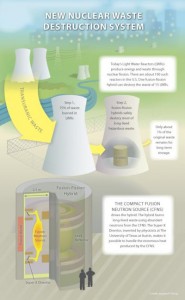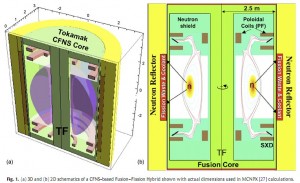Jan
29
Cleaning Up Nuclear with Nuclear
January 29, 2009 | 2 Comments
Mike Kotschenreuther, senior research scientist with the Institute for Fusion Studies (IFS) and Department of Physics at the University of Texas at Austin is leading a team that has designed a hybrid fusion-fission reactor to burn fission reactor waste. When fully developed, the design would use fusion neutron products to eliminate most of the transuranic waste produced by current nuclear power plants.
Immediately what comes to mind is just how are they going to get a steady fusion, when the grand goal is to get fusion designs into net energy production. Well, tokamak fusion can be done, steadily if you’re willing to forgo net output, drawing power instead of making it. So the hybrid principle makes sense, drive some fusion to yield neutrons and focus the neutrons into your fission waste – and you have a burner for those nasty leftovers from old reactor designs that burn a very small percent of the original fuel.
What makes this thing viable is the new diverter design that guides the neutrons out of the small tokamak fusion source into the used fission fuel. The abstract in the Journal Fusion Engineering and Design says, “The center piece of this fuel cycle, the high power density compact fusion neutron source is made possible by a new diverter with a heat-handling capacity five times that of the ‘standard alternative.’” (Click here for the study PDF.) The motivation is the need for disposal of the used nuclear fuel.
On the other hand . . . keep in mind that when you read about how efficient nuclear reactors are, they’re usually discussing how efficient the heat from the reactor is turned into electricity. What’s not said is most of the used fuel in the U.S. is only minimally burned leaving the vast majority of the energy in the fuel yet to be utilized. It can be 19 times the total power from a nuclear reactor’s fuel remaining to be used.
With the political atmosphere denying or delaying development and installation of reprocessing in the U.S., the nation is destined to need disposal instead of recycling the uranium resource. France and Japan (amazingly) both reprocess used fuel so gathering much more power from the fuel base. There are design proposals yet to complete the regulatory minefield to burn uranium fuel much more completely, thorium reactors that use very small amounts to ignite the thorium and designs where the thorium reactor burns the used uranium products, and other ideas that utilize the natural resource of uranium in far greater proportions.
Let’s assume that the governing law and regulatory bodies cannot get it together for expanding the breadth of nuclear power systems and vastly increase power availability. That’s more probable than any sensible ratepayer or taxpayer should allow, meanwhile a smallish pile of fuel rods from current reactors has built up. But its enough that much of the repository at Yucca Mountain would be filled in already. The Texans realize that their technology could only be a bridge to new technology for nuclear fuels and reactors. A strict regulatory process of denial would get us to the point that we would need to dispense with used fission fuels with perhaps as much as 95% of the energy remaining. There’s your “Oh My God” moment.
Meanwhile, the Texan’s centerpiece is a high power Compact Fusion Neutron Source (CFNS) made possible by a crucial invention. Called the Super X Divertor, it is designed to handle the enormous heat and particle fluxes peculiar to compact devices; it would enable the CFNS to safely produce large amounts of neutrons without destroying the system. Research scientist Prashant Valanju says, “The intense heat generated in a nuclear fusion device can literally destroy the walls of the machine and that is the thing that has been holding back a highly compact source of nuclear fusion.”
The CFNS is based on a tokamak, a machine known as a “magnetic bottle” that is highly successful in confining high temperature (more than 100 million degrees Celsius) fusion plasmas for sufficiently long times. The CFNS is designed to be no larger than a small room, and much fewer of the devices would be needed compared to other schemes that are being investigated for similar processes. The scientists say in combination with the substantial decrease in the need for geological storage, the CFNS-enabled waste-destruction system would be much cheaper and faster than other processes.
Valanju says a fusion-fission hybrid reactor has been an idea in the physics community for a long time. “It’s always been known that fusion is good at producing neutrons and fission is good at making energy. Now, we have shown that we can get fusion to produce a lot of neutrons in a small space.” The physicists say that harnessing the product of fusion neutrons can be achieved in the near term.
The scientists say their Super X Divertor invention has already gained acceptance in the fusion community. Several groups are considering implemented the Super X Divertor on their machines, including the MAST tokamak in the United Kingdom, and the DIIID (General Atomics) and NSTX (Princeton University) in the U.S. Next steps will include performing extended simulations, transforming the concept into an engineering project, and seeking funding for building a prototype.
Back in the other hand the researchers clearly have an elegant process to greatly reduce the amount of uranium fuel wastes. I certainly believe the project deserves to proceed as the necessity to dispose of fission wastes must be undertaken and the fusion-fission concept looks economical.
But before we assume that sending off a large inventory of valuable “waste” fuel to be uselessly destructed, the remaining energy should be extracted. Or perhaps the process steps themselves could be optimized to achieve heat output useful for power generation. There must be a great deal of it unaccounted for in the current stage of explanation and this segment of understanding might be the next step in the development.
Both hands hold a congratulatory note to the research team. The development of a “valve” to handle high-speed neutrons is quite an achievement on its own.
Comments
2 Comments so far




[…] Excerpted from:Cleaning Up Nuclear with Nuclear | New bEnergy/b and Fuel […]
It I understand correctly, this would destroy practically any radioactive waste? Then build it.
It does not matter if we start making a smaller mess with our next generation designs. Let’s clean up the mess we have right now.
We are bound to learn a lot about fusion in the process.